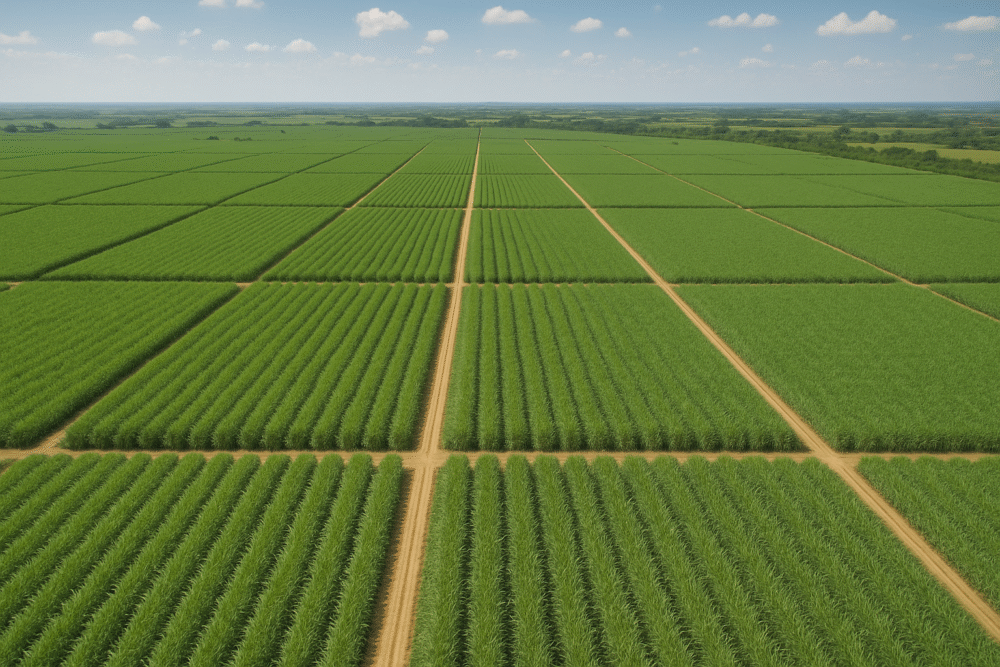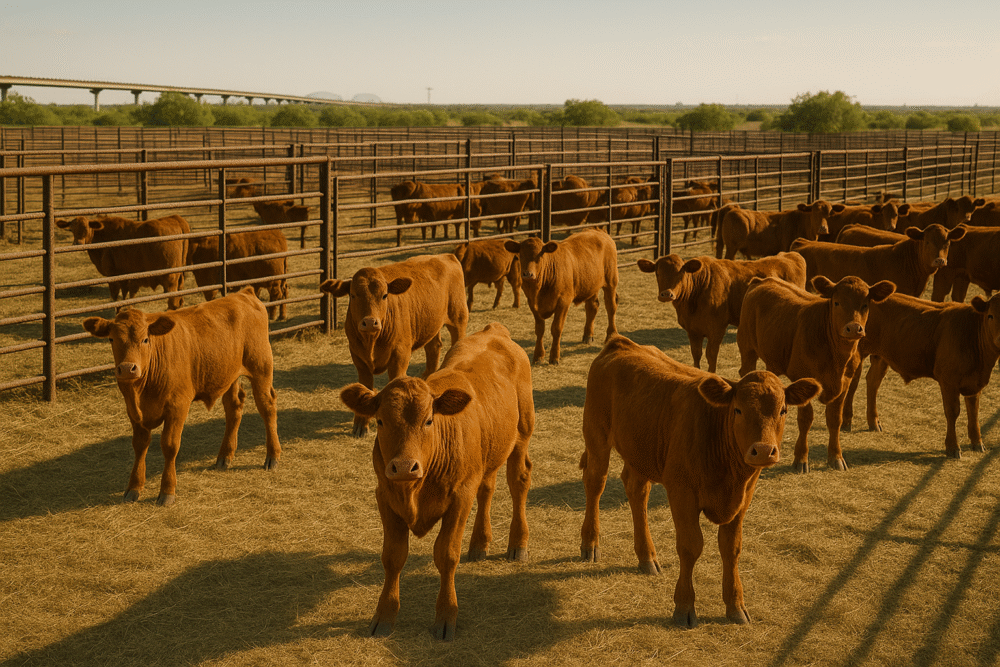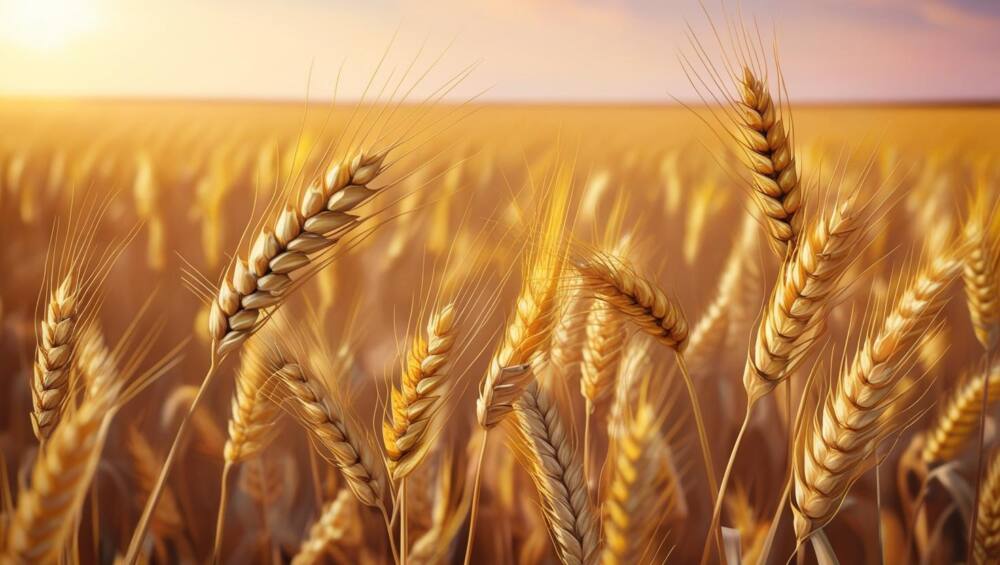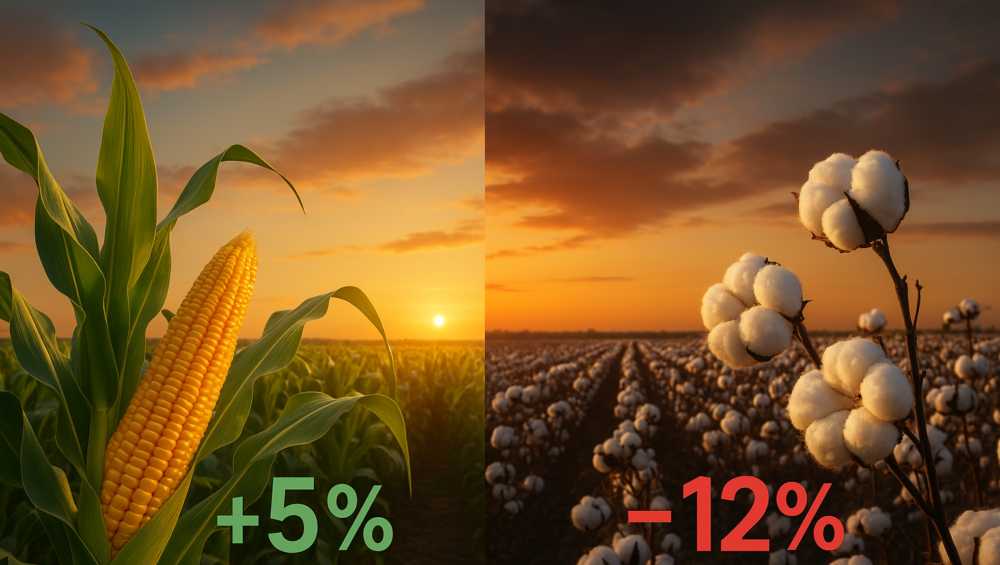Supplies Abundant, Acreage in Question for 2025 Cotton Futures
Share This Story, Choose Your Platform!
February in the cotton market is often a time of looking back and looking ahead. Recent harvests are complete, and planting decisions loom. The latest USDA data confirms what many suspected: global cotton stocks are ample. Yet, inconsistency in demand, heavy speculative bets, and potential acreage changes in the U.S. mean the market could still surprise. Understanding the 2024/25 U.S. crop, the fundamentals influencing 2025/26 plantings, and the global balance sheet is key to anticipating cotton price and trade trends.
WASDE: The Numbers at a Glance
The USDA’s report is the go-to source for agricultural market data. This month, the report highlighted comfortable global cotton inventories, around 77.94 million bales. While down a bit from last year’s 80.35 million, these are still substantial levels. Global consumption is projected to rise modestly, about 1.8% year-over-year. For significant stock reductions, that pace likely needs to quicken.
Looking regionally, U.S. cotton production for 2024/25 is up considerably, estimated at 14.41 million bales compared to last year’s 12.44 million. In China, despite planting less land, they’ve maintained production above 30 million bales through better yields. Brazil is expected to surpass last years record with 16.6 million bales projection.
U.S. Crop 2024/25: Outcome Set
Entering February, the U.S. cotton harvest is nearly done, 85% complete, right on pace with the average. With 11.17 million acres planted, yields are expected to average 836 pounds per acre. Total U.S. output should land between 14.26 and 14.41 million bales. This production rebound offers supply security for now. However, it also suggests U.S. stocks will remain adequate unless demand picks up quickly.
Acreage in 2025/26: Farmers Weigh Options
With the current crop picture clear, the focus turns to 2025/26 planting. Farmers are starting to think about planting, beginning as early as March. Current cotton prices and their expenses will guide how many acres go to cotton versus alternatives like corn, soybeans, and sorghum.
Recently, March cotton futures closed around 68.35 cents per pound, with new crop December futures at 71.50 cents. Many see these prices as uninspiring, especially compared to other crops. For instance, soybeans might offer better returns per acre right now. Farmers are also still facing high input costs. Fertilizer, for example, remains expensive and interest rates are still near recent highs. This cost pressure, combined with unexciting cotton prices, makes switching away from cotton more appealing. Analysts increasingly anticipate a 5% to 10% drop in U.S. cotton acreage next season if prices don’t improve.
Global Production: Brazil and India Key
Worldwide cotton production is projected to be relatively stable, around 119.45 million bales. China’s production is holding strong, above 30 million bales, despite less acreage, thanks to government support in technology to create more efficiency and higher yields. This reduces their immediate import needs.
Brazil is becoming a major cotton exporter. They’re planting a lot of cotton, around 10.4 – 10.9 million acres, with good yields, averaging 1,500-1,700 lbs/acre. The currency exchange rate and efficient farming make Brazilian cotton very competitive. 2023/2024 was a record year in Brazil and it is projected they will again break a record with 16.6 million bales. India, a global leader that typically produces in excess of 30 million bales, is less predictable. Their cotton crop relies heavily on the monsoon rains. A poor monsoon could hurt India’s cotton output and push global prices up. India is projecting 25 million bales in MY 24/25, a 15 year low while imports have surged over 300%.
Trade and Demand: A Cautious Market
The U.S. is expected to export 11.00 million bales of cotton this marketing year, a significant volume. However, they are facing more competition from Brazil who has eclipsed 12 million bales. China’s domestic production also means less urgent import demand from them. Major cotton importers like Vietnam, Turkey, and Bangladesh are being cautious with imports, watching the overall economy.
Apparel sales data is mixed. Consumer spending on clothes is still below pre-pandemic levels in many places. U.S. apparel retail sales, for example, were recently down year-over-year. This cautious consumer climate makes textile mills hesitant to build up cotton inventories, limiting chances for a quick jump in demand for cotton or prices. Trade agreements are also challenging trade patterns, potentially redirecting traditional U.S. cotton exports and encouraging smaller countries to grow their own cotton industries.
Speculators: Betting on Lower Prices
Speculative traders play a big role in cotton futures. Recent data shows large speculators holding a large net-short position, betting on lower prices. This bearish stance reflects ample global stocks and weak demand expectations.
However, this large short position can also create price volatility. A surprise, like strong export sales, bad weather in a key region, or unexpected demand could force these traders to quickly buy back contracts to cover their shorts, potentially causing a rapid price increase. For now, most speculators seem to think such surprises are unlikely soon.
Seasonal Price Trends: March and July Contracts Weak
Historically, March and July cotton futures often see price increases. March benefits from mills buying for current needs, and July from old-crop supply concerns and new-crop uncertainties. But this year, these seasonal trends are muted by the overall supply and demand situation.
March cotton futures are trading in the upper 60-cent range, seasonally lower than usual for this time. July futures are also below historical averages. Short-term price bumps are still possible, perhaps due to U.S. planting weather. But the main story is ample supply and cautious demand. If early planting reports suggest big acreage cuts for 2025/26, July futures might start to reflect tighter future supplies. For now, it’s still early.
Key Points for Early 2025
- U.S. Crop 2024/25 Mostly Determined: Harvest progress means the U.S. supply for this marketing year is largely set.
- U.S. Acreage in 2025/26 Could Shrink: Current prices and input costs might push farmers to plant less cotton next season, possibly down 5-10%.
- Global Cotton Stocks Remain Large: World inventories near 78 million bales mean a price rally needs a production problem or a demand surge.
- Heavy Speculator Short Positions: This could limit price gains but also lead to quick rallies if market views change.
Looking Forward: Managing Risk in a Calm Market
The cotton market in February 2025 has a generally bearish feel. Supplies are good, production is steady, and demand growth is slow. But, things can change. A poor monsoon in India, new trade policies, or U.S. planting issues could quickly change the picture. Conversely, weak apparel demand or a stronger dollar could add to price pressure.
Cotton producers should focus on managing costs and deciding on 2025/26 acreage. Strategies like locking in input costs, considering crop insurance, and watching alternative crop prices will be important. Merchants and mills need to track export sales, USDA reports, and weather. The large speculator short position adds both risk and opportunity. Traders should monitor USDA export data, weather forecasts, and speculator positioning for market moves.
Before the pandemic, cotton prices traded this low in the fall of 2019, dropping below 60 cents. Zooming out on the chart, there is a case to be made that we could be near support, with more risk to the upside in 2025.
Share This Story, Choose Your Platform!
Supplies Abundant, Acreage in Question for 2025 Cotton Futures
Share This Story, Choose Your Platform
February in the cotton market is often a time of looking back and looking ahead. Recent harvests are complete, and planting decisions loom. The latest USDA data confirms what many suspected: global cotton stocks are ample. Yet, inconsistency in demand, heavy speculative bets, and potential acreage changes in the U.S. mean the market could still surprise. Understanding the 2024/25 U.S. crop, the fundamentals influencing 2025/26 plantings, and the global balance sheet is key to anticipating cotton price and trade trends.
WASDE: The Numbers at a Glance
The USDA’s report is the go-to source for agricultural market data. This month, the report highlighted comfortable global cotton inventories, around 77.94 million bales. While down a bit from last year’s 80.35 million, these are still substantial levels. Global consumption is projected to rise modestly, about 1.8% year-over-year. For significant stock reductions, that pace likely needs to quicken.
Looking regionally, U.S. cotton production for 2024/25 is up considerably, estimated at 14.41 million bales compared to last year’s 12.44 million. In China, despite planting less land, they’ve maintained production above 30 million bales through better yields. Brazil is expected to surpass last years record with 16.6 million bales projection.
U.S. Crop 2024/25: Outcome Set
Entering February, the U.S. cotton harvest is nearly done, 85% complete, right on pace with the average. With 11.17 million acres planted, yields are expected to average 836 pounds per acre. Total U.S. output should land between 14.26 and 14.41 million bales. This production rebound offers supply security for now. However, it also suggests U.S. stocks will remain adequate unless demand picks up quickly.
Acreage in 2025/26: Farmers Weigh Options
With the current crop picture clear, the focus turns to 2025/26 planting. Farmers are starting to think about planting, beginning as early as March. Current cotton prices and their expenses will guide how many acres go to cotton versus alternatives like corn, soybeans, and sorghum.
Recently, March cotton futures closed around 68.35 cents per pound, with new crop December futures at 71.50 cents. Many see these prices as uninspiring, especially compared to other crops. For instance, soybeans might offer better returns per acre right now. Farmers are also still facing high input costs. Fertilizer, for example, remains expensive and interest rates are still near recent highs. This cost pressure, combined with unexciting cotton prices, makes switching away from cotton more appealing. Analysts increasingly anticipate a 5% to 10% drop in U.S. cotton acreage next season if prices don’t improve.
Global Production: Brazil and India Key
Worldwide cotton production is projected to be relatively stable, around 119.45 million bales. China’s production is holding strong, above 30 million bales, despite less acreage, thanks to government support in technology to create more efficiency and higher yields. This reduces their immediate import needs.
Brazil is becoming a major cotton exporter. They’re planting a lot of cotton, around 10.4 – 10.9 million acres, with good yields, averaging 1,500-1,700 lbs/acre. The currency exchange rate and efficient farming make Brazilian cotton very competitive. 2023/2024 was a record year in Brazil and it is projected they will again break a record with 16.6 million bales. India, a global leader that typically produces in excess of 30 million bales, is less predictable. Their cotton crop relies heavily on the monsoon rains. A poor monsoon could hurt India’s cotton output and push global prices up. India is projecting 25 million bales in MY 24/25, a 15 year low while imports have surged over 300%.
Trade and Demand: A Cautious Market
The U.S. is expected to export 11.00 million bales of cotton this marketing year, a significant volume. However, they are facing more competition from Brazil who has eclipsed 12 million bales. China’s domestic production also means less urgent import demand from them. Major cotton importers like Vietnam, Turkey, and Bangladesh are being cautious with imports, watching the overall economy.
Apparel sales data is mixed. Consumer spending on clothes is still below pre-pandemic levels in many places. U.S. apparel retail sales, for example, were recently down year-over-year. This cautious consumer climate makes textile mills hesitant to build up cotton inventories, limiting chances for a quick jump in demand for cotton or prices. Trade agreements are also challenging trade patterns, potentially redirecting traditional U.S. cotton exports and encouraging smaller countries to grow their own cotton industries.
Speculators: Betting on Lower Prices
Speculative traders play a big role in cotton futures. Recent data shows large speculators holding a large net-short position, betting on lower prices. This bearish stance reflects ample global stocks and weak demand expectations.
However, this large short position can also create price volatility. A surprise, like strong export sales, bad weather in a key region, or unexpected demand could force these traders to quickly buy back contracts to cover their shorts, potentially causing a rapid price increase. For now, most speculators seem to think such surprises are unlikely soon.
Seasonal Price Trends: March and July Contracts Weak
Historically, March and July cotton futures often see price increases. March benefits from mills buying for current needs, and July from old-crop supply concerns and new-crop uncertainties. But this year, these seasonal trends are muted by the overall supply and demand situation.
March cotton futures are trading in the upper 60-cent range, seasonally lower than usual for this time. July futures are also below historical averages. Short-term price bumps are still possible, perhaps due to U.S. planting weather. But the main story is ample supply and cautious demand. If early planting reports suggest big acreage cuts for 2025/26, July futures might start to reflect tighter future supplies. For now, it’s still early.
Key Points for Early 2025
- U.S. Crop 2024/25 Mostly Determined: Harvest progress means the U.S. supply for this marketing year is largely set.
- U.S. Acreage in 2025/26 Could Shrink: Current prices and input costs might push farmers to plant less cotton next season, possibly down 5-10%.
- Global Cotton Stocks Remain Large: World inventories near 78 million bales mean a price rally needs a production problem or a demand surge.
- Heavy Speculator Short Positions: This could limit price gains but also lead to quick rallies if market views change.
Looking Forward: Managing Risk in a Calm Market
The cotton market in February 2025 has a generally bearish feel. Supplies are good, production is steady, and demand growth is slow. But, things can change. A poor monsoon in India, new trade policies, or U.S. planting issues could quickly change the picture. Conversely, weak apparel demand or a stronger dollar could add to price pressure.
Cotton producers should focus on managing costs and deciding on 2025/26 acreage. Strategies like locking in input costs, considering crop insurance, and watching alternative crop prices will be important. Merchants and mills need to track export sales, USDA reports, and weather. The large speculator short position adds both risk and opportunity. Traders should monitor USDA export data, weather forecasts, and speculator positioning for market moves.
Before the pandemic, cotton prices traded this low in the fall of 2019, dropping below 60 cents. Zooming out on the chart, there is a case to be made that we could be near support, with more risk to the upside in 2025.
Share This Story, Choose Your Platform!
Supplies Abundant, Acreage in Question for 2025 Cotton Futures
Share This Story, Choose Your Platform
February in the cotton market is often a time of looking back and looking ahead. Recent harvests are complete, and planting decisions loom. The latest USDA data confirms what many suspected: global cotton stocks are ample. Yet, inconsistency in demand, heavy speculative bets, and potential acreage changes in the U.S. mean the market could still surprise. Understanding the 2024/25 U.S. crop, the fundamentals influencing 2025/26 plantings, and the global balance sheet is key to anticipating cotton price and trade trends.
WASDE: The Numbers at a Glance
The USDA’s report is the go-to source for agricultural market data. This month, the report highlighted comfortable global cotton inventories, around 77.94 million bales. While down a bit from last year’s 80.35 million, these are still substantial levels. Global consumption is projected to rise modestly, about 1.8% year-over-year. For significant stock reductions, that pace likely needs to quicken.
Looking regionally, U.S. cotton production for 2024/25 is up considerably, estimated at 14.41 million bales compared to last year’s 12.44 million. In China, despite planting less land, they’ve maintained production above 30 million bales through better yields. Brazil is expected to surpass last years record with 16.6 million bales projection.
U.S. Crop 2024/25: Outcome Set
Entering February, the U.S. cotton harvest is nearly done, 85% complete, right on pace with the average. With 11.17 million acres planted, yields are expected to average 836 pounds per acre. Total U.S. output should land between 14.26 and 14.41 million bales. This production rebound offers supply security for now. However, it also suggests U.S. stocks will remain adequate unless demand picks up quickly.
Acreage in 2025/26: Farmers Weigh Options
With the current crop picture clear, the focus turns to 2025/26 planting. Farmers are starting to think about planting, beginning as early as March. Current cotton prices and their expenses will guide how many acres go to cotton versus alternatives like corn, soybeans, and sorghum.
Recently, March cotton futures closed around 68.35 cents per pound, with new crop December futures at 71.50 cents. Many see these prices as uninspiring, especially compared to other crops. For instance, soybeans might offer better returns per acre right now. Farmers are also still facing high input costs. Fertilizer, for example, remains expensive and interest rates are still near recent highs. This cost pressure, combined with unexciting cotton prices, makes switching away from cotton more appealing. Analysts increasingly anticipate a 5% to 10% drop in U.S. cotton acreage next season if prices don’t improve.
Global Production: Brazil and India Key
Worldwide cotton production is projected to be relatively stable, around 119.45 million bales. China’s production is holding strong, above 30 million bales, despite less acreage, thanks to government support in technology to create more efficiency and higher yields. This reduces their immediate import needs.
Brazil is becoming a major cotton exporter. They’re planting a lot of cotton, around 10.4 – 10.9 million acres, with good yields, averaging 1,500-1,700 lbs/acre. The currency exchange rate and efficient farming make Brazilian cotton very competitive. 2023/2024 was a record year in Brazil and it is projected they will again break a record with 16.6 million bales. India, a global leader that typically produces in excess of 30 million bales, is less predictable. Their cotton crop relies heavily on the monsoon rains. A poor monsoon could hurt India’s cotton output and push global prices up. India is projecting 25 million bales in MY 24/25, a 15 year low while imports have surged over 300%.
Trade and Demand: A Cautious Market
The U.S. is expected to export 11.00 million bales of cotton this marketing year, a significant volume. However, they are facing more competition from Brazil who has eclipsed 12 million bales. China’s domestic production also means less urgent import demand from them. Major cotton importers like Vietnam, Turkey, and Bangladesh are being cautious with imports, watching the overall economy.
Apparel sales data is mixed. Consumer spending on clothes is still below pre-pandemic levels in many places. U.S. apparel retail sales, for example, were recently down year-over-year. This cautious consumer climate makes textile mills hesitant to build up cotton inventories, limiting chances for a quick jump in demand for cotton or prices. Trade agreements are also challenging trade patterns, potentially redirecting traditional U.S. cotton exports and encouraging smaller countries to grow their own cotton industries.
Speculators: Betting on Lower Prices
Speculative traders play a big role in cotton futures. Recent data shows large speculators holding a large net-short position, betting on lower prices. This bearish stance reflects ample global stocks and weak demand expectations.
However, this large short position can also create price volatility. A surprise, like strong export sales, bad weather in a key region, or unexpected demand could force these traders to quickly buy back contracts to cover their shorts, potentially causing a rapid price increase. For now, most speculators seem to think such surprises are unlikely soon.
Seasonal Price Trends: March and July Contracts Weak
Historically, March and July cotton futures often see price increases. March benefits from mills buying for current needs, and July from old-crop supply concerns and new-crop uncertainties. But this year, these seasonal trends are muted by the overall supply and demand situation.
March cotton futures are trading in the upper 60-cent range, seasonally lower than usual for this time. July futures are also below historical averages. Short-term price bumps are still possible, perhaps due to U.S. planting weather. But the main story is ample supply and cautious demand. If early planting reports suggest big acreage cuts for 2025/26, July futures might start to reflect tighter future supplies. For now, it’s still early.
Key Points for Early 2025
- U.S. Crop 2024/25 Mostly Determined: Harvest progress means the U.S. supply for this marketing year is largely set.
- U.S. Acreage in 2025/26 Could Shrink: Current prices and input costs might push farmers to plant less cotton next season, possibly down 5-10%.
- Global Cotton Stocks Remain Large: World inventories near 78 million bales mean a price rally needs a production problem or a demand surge.
- Heavy Speculator Short Positions: This could limit price gains but also lead to quick rallies if market views change.
Looking Forward: Managing Risk in a Calm Market
The cotton market in February 2025 has a generally bearish feel. Supplies are good, production is steady, and demand growth is slow. But, things can change. A poor monsoon in India, new trade policies, or U.S. planting issues could quickly change the picture. Conversely, weak apparel demand or a stronger dollar could add to price pressure.
Cotton producers should focus on managing costs and deciding on 2025/26 acreage. Strategies like locking in input costs, considering crop insurance, and watching alternative crop prices will be important. Merchants and mills need to track export sales, USDA reports, and weather. The large speculator short position adds both risk and opportunity. Traders should monitor USDA export data, weather forecasts, and speculator positioning for market moves.
Before the pandemic, cotton prices traded this low in the fall of 2019, dropping below 60 cents. Zooming out on the chart, there is a case to be made that we could be near support, with more risk to the upside in 2025.






